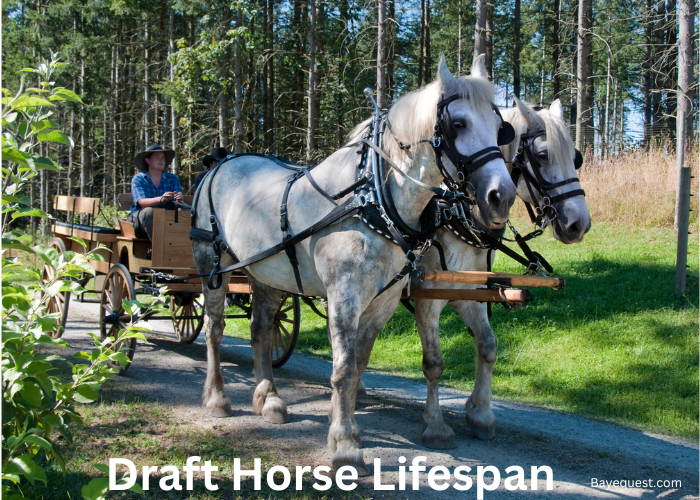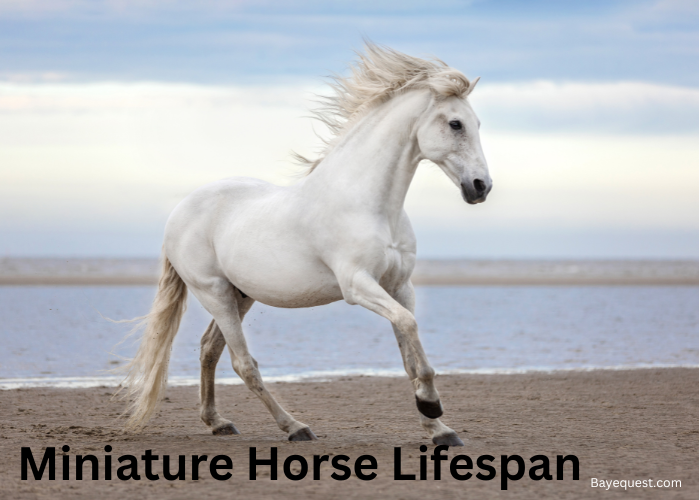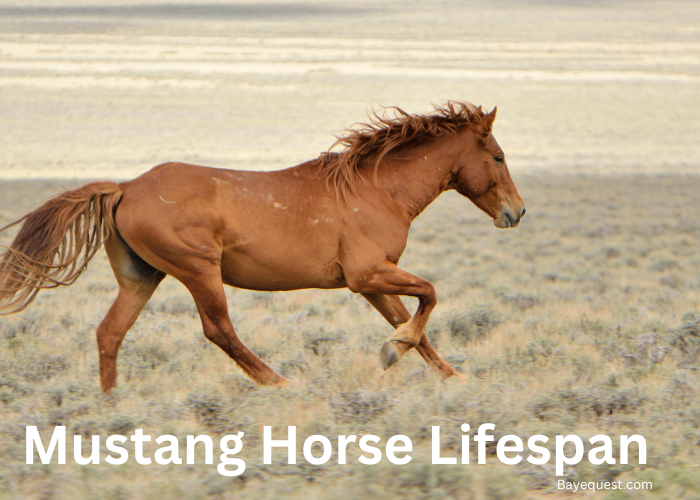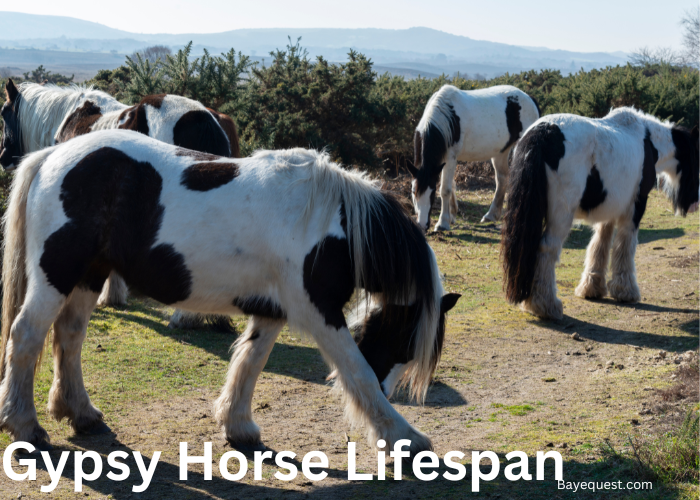Draft horses are large, powerful horses bred for heavy work. They pull plows, haul loads, and perform tasks that require strength and endurance.
Known for their calm temperament, they’re often used in farming, logging, and even parades.
But how long do these strong, hardworking horses actually live? Various factors influence their lifespan.
Some draft horses live well into their 20s, while others may age faster. Let’s explore what impacts their longevity and how to help them live healthier, longer lives.
What is the Average Draft Horse Lifespan?
Draft horses live 18 to 25 years. Proper care, including balanced nutrition, regular exercise, and routine veterinary check-ups, can extend their lifespan. Factors like breed, workload, and living conditions also play a role. Maintaining a healthy weight and managing joint health is key to a longer, happier life.
What is a Draft Horse?
A draft horse is a large, muscular horse bred for heavy work. They’re built to pull heavy loads, plow fields, and handle tough tasks that lighter horses can’t.
Draft horses have strong, sturdy bodies with thick legs and powerful muscles. They’re known for their calm and gentle nature, making them great for farm work and pulling carriages.
Some popular draft horse breeds include the Clydesdale, Shire, and Percheron. These hardworking horses have been essential to agriculture, logging, and transport for centuries.
Related read: What is the Difference Between a Clydesdale and a Draft Horse?
Origin and History of the Draft Horse
Draft horses have a long and fascinating history that dates back thousands of years. Their origins can be traced to Europe, where they were bred for their size, strength, and stamina.
Early draft horses were used in agriculture and warfare, pulling plows, carts, and heavy loads.
During the Middle Ages, larger and stronger horses were needed for knights in armor, leading to the development of the massive warhorses, or “great horses.”
As agriculture expanded, these horses were further bred for plowing fields and hauling goods. This gave rise to the draft breeds we know today.
Breeds like the Shire, Clydesdale, and Percheron emerged from selective breeding. They were bred for strength, endurance, and calm temperaments.
Over time, these horses became vital to farming communities and industries, especially before the advent of machinery.
Draft horses played a crucial role in industrial and agricultural development in the 19th and early 20th centuries. They hauled logs, plowed large fields, and even delivered goods in cities.
Though modern machinery has replaced much of their traditional work, draft horses remain beloved for their power, grace, and gentle nature.
Today, they are often used for recreational activities, competitions, and ceremonial events.
Characteristics of a Draft Horse
Here’s a table that offers a clear and concise overview of the characteristics of draft horses.
| Characteristic | Description |
| Size and strength | Large, muscular build with thick necks and broad chests. Height ranges from 16 to 19 hands (64 to 76 inches). |
| Weight | Typically weighs between 1,500 to 2,200 pounds, depending on the breed. |
| Leg structure | Sturdy, powerful legs designed to support weight and handle heavy work. |
| Coat and color | Dense coat with colors like bay, black, chestnut, gray, and roan. Some breeds have feathering on lower legs. |
| Temperament | Calm, gentle, and patient, often called “gentle giants” for their friendly nature. |
| Endurance and stamina | Capable of working long hours without tiring, ideal for heavy labor and pulling loads. |
| Agility | Despite their size, they can perform precise movements, especially when trained for specific tasks. |
| Hardiness | Adaptable to various climates but requires proper care to maintain health. |
| Health considerations | Prone to joint issues and weight management challenges, requiring regular veterinary care. |
Draft Horse Lifespan
Draft horses generally live between 18 and 25 years, similar to many other horse breeds. However, their lifespan can vary depending on the breed, care, and lifestyle.
Some draft horses can live even longer, especially when they are well-cared for and not subjected to heavy physical work.
Due to their large size and weight, draft horses face unique challenges compared to lighter horse breeds. This can sometimes lead to health issues that may shorten their lifespan.
However, with proper care, some draft horses have lived well into their late twenties or even early thirties.
Remember that a draft horse’s lifestyle plays a significant role in how long they live.
Horses used primarily for companionship or light work tend to have longer lifespans compared to those used for heavy labor.
Factors Affecting the Lifespan of a Draft Horse
Draft horses can live long, healthy lives when given proper care. However, several factors can impact how long they live.
Understanding these factors helps draft horse owners make informed decisions to support their horse’s well-being. Let’s take a closer look at the key factors that affect a draft horse’s lifespan.
Breed differences
Different draft horse breeds have varying lifespans. Some breeds are naturally more robust and resilient.
For example, Percherons and Clydesdales are known for their hardiness. They often live longer than breeds that are prone to genetic health issues.
Shires, for instance, can be more susceptible to chronic progressive lymphedema. This condition can shorten their lifespan.
Genetics play a crucial role here. Breeds with fewer inherent health problems generally live longer.
Size and weight
Draft horses are much larger than other horse breeds. They usually weigh between 1,500 and 2,200 pounds.
Their massive size puts extra strain on their joints and bones. This can lead to arthritis and other joint issues as they age.
Additionally, the heart and circulatory system have to work harder to support such a large body. This makes draft horses more prone to heart problems.
Workload and activity
Draft horses are built for heavy work. They often pull loads, plow fields, and do other physically demanding tasks.
While they are strong, too much work can cause wear and tear on their bodies. Heavy labor can lead to joint deterioration and muscle injuries.
Horses that are used for intense work daily may age faster. In contrast, those that do lighter work or are kept mainly for companionship tend to live longer.
Diet and nutrition
Good nutrition is vital for draft horses. They need a balanced diet to maintain a healthy weight.
High-quality forage is essential to support their large digestive system. They also need vitamins and minerals to keep their bones and muscles strong.
Overfeeding can lead to obesity, which stresses the joints and the heart. Underfeeding can result in weakness and poor immune function.
Draft horses also need plenty of fresh water to stay hydrated. Proper nutrition supports their overall health and can extend their lifespan.
Healthcare and maintenance
Regular healthcare is essential for draft horses. Routine veterinary check-ups help catch health issues early.
Vaccinations protect them from common diseases, while regular deworming prevents internal parasites.
Draft horses also need consistent hoof care to avoid infections and lameness. Dental care is important too, as poor teeth can affect eating and nutrition.
Preventive healthcare helps maintain their well-being. Neglecting these basics can lead to chronic issues that shorten their lifespan.
Living conditions
The environment where draft horses live greatly affects their health. They need spacious and clean living areas.
Draft horses are prone to respiratory problems if kept in dusty or dirty conditions. Adequate shelter protects them from harsh weather.
Proper bedding reduces the risk of joint pain and pressure sores. They also benefit from having enough space to move around freely.
This helps keep their muscles flexible and reduces stiffness. Clean water and a dry, safe area for resting are also essential.
Good living conditions promote longevity and well-being.
Social interaction and mental well-being
Draft horses thrive on social interaction. They are social animals and enjoy the company of other horses or familiar humans.
Isolation can cause stress and anxiety. Prolonged stress weakens their immune system and affects their overall health.
Boredom can also lead to behavioral issues like cribbing or pacing. Engaging draft horses with regular social activities helps maintain their mental well-being.
Happy, relaxed horses tend to live longer. Providing companionship and mental stimulation is just as important as physical care.
Genetics and lineage
Genetics play a vital role in a draft horse’s lifespan. Horses from long-lived families often inherit better health traits.
Responsible breeding practices focus on selecting healthy, robust horses. This helps reduce the risk of inherited diseases.
In contrast, poor breeding practices can lead to genetic problems. Issues like joint weakness or metabolic disorders may appear early in life.
Choosing horses from reputable breeders increases the chance of a longer, healthier life.
How to Improve the Lifespan of a Draft Horse
Improving the lifespan of your draft horse starts with understanding their unique needs. These gentle giants require special care because of their size and the work they often do.
Luckily, there are some simple yet effective ways you can help them live a longer, healthier life.
Let’s dive into a few practical tips to make sure your draft horse stays happy and healthy for years to come.
Prioritize nutrition
Feeding your draft horse the right diet is crucial. These big guys need a lot of forage to keep their digestive system running smoothly.
Provide high-quality hay and plenty of fresh water. Also, give them a balanced diet that includes the necessary vitamins and minerals.
Draft horses can easily gain weight, so watch their portions. If you’re unsure about the right diet, don’t hesitate to consult your vet or an equine nutritionist.
Keeping their weight in check will do wonders for their joints and overall health.
Keep them active, but don’t overdo it
Draft horses are built for hard work, but that doesn’t mean they should be overworked. Find a balance between keeping them active and giving them plenty of rest.
Light to moderate exercise is great for maintaining muscle tone and joint flexibility. If your horse does a lot of heavy pulling or plowing, make sure to schedule regular breaks.
Let them stretch and relax. Overworking can lead to joint stress and injuries, which might shorten their lifespan.
Make health care a routine
Don’t wait for problems to pop up. Regular vet check-ups are a must.
Draft horses are prone to joint issues and hoof problems, so regular evaluations can catch these issues early.
Keep up with vaccinations and deworming schedules. Dental care is also as important.
Draft horses can develop sharp points on their teeth, which can make eating uncomfortable. A simple dental check twice a year can help keep their mouth healthy and pain-free.
Manage their living environment
Creating a comfortable space for your draft horse makes a big difference. Make sure their stall is clean and spacious enough to move around.
Draft horses need room to stretch without bumping into walls. Their bedding should be soft and dry to prevent joint stiffness and sores.
Provide shelter from harsh weather, whether it’s extreme heat or cold. If your horse spends a lot of time outside, ensure they have shade and a windbreak.
Keep them socially and mentally stimulated
Draft horses are social animals. They don’t just thrive on physical care but also on emotional well-being.
Make time to interact with your horse daily. Grooming, talking to them, and even a gentle walk can boost their mood.
If possible, let them hang out with other horses. Social interactions help reduce stress, which can have a direct impact on their lifespan.
You’ll notice a happier, more content horse when they feel connected and loved.
Focus on joint care
Draft horses put a lot of strain on their joints because of their size. You can help by ensuring they don’t carry excessive weight.
Regular hoof trimming helps maintain proper balance and reduces joint stress. You might also consider joint supplements, especially as they age.
Keep an eye out for stiffness or lameness, and address any issues early on. The goal is to keep them moving comfortably for as long as possible.
Monitor their weight
It’s easy for draft horses to put on a few extra pounds, especially if they’re not working as much.
Excess weight strains their joints and can lead to metabolic problems. Use a weight tape to keep track of their size.
Adjust their diet if you notice they’re getting a bit round. Including some light exercise can also help them stay fit.
If you’re unsure about their ideal weight, your vet can give you some guidance.
Be aware of their genetics
If you’re buying a draft horse or breeding one, pay attention to lineage. Some health issues are hereditary, like joint problems or metabolic disorders.
Choose horses from long-lived, healthy lines whenever possible. Knowing your horse’s genetic background can help you prepare for potential issues and take preventive measures early.
Draft Horse Health Issues
Draft horses are prone to certain health problems due to their large size and workload. Here are some of the most common issues they face:
Joint and bone problems
Draft horses often experience joint issues, such as arthritis and degenerative joint disease. Their heavy weight puts extra stress on their joints, especially if they perform hard labor.
You may notice stiffness, lameness, or swelling. Regular exercise, joint supplements, and maintaining a healthy weight can help manage these problems.
Laminitis and hoof disorders
Laminitis is a painful inflammation of the hoof’s inner structures. Draft horses are at risk due to their size and weight.
It can be triggered by obesity, poor diet, or excessive workload. Symptoms include lameness, heat in the hooves, and reluctance to move.
Related read: Signs of Founder in Horses.
Heart and respiratory conditions
The large body size of draft horses can strain their cardiovascular and respiratory systems.
They may develop conditions like heart murmurs or respiratory issues, especially if overweight or overworked.
Signs include labored breathing, coughing, or fatigue. Keeping them fit and managing their workload helps reduce the risk.
Weight and metabolism issues
Draft horses can easily gain weight, leading to obesity and metabolic problems like equine metabolic syndrome (EMS).
Extra weight stresses their joints and can increase the risk of laminitis.
Monitoring their diet, portion control, and regular exercise are crucial to maintaining a healthy weight and metabolism.
Conclusion
Caring for a draft horse takes effort, but it’s rewarding. These gentle giants can live long, healthy lives with the right care.
Focus on balanced nutrition, regular exercise, and routine health check-ups. Create a comfortable living space and give them plenty of social interaction.
Monitor their weight and look for joint issues. Understand their unique needs and adjust your care routine as they age.
With love and attention, your draft horse can thrive for many years. Their happiness and well-being are in your hands.







